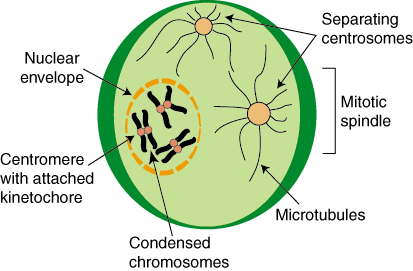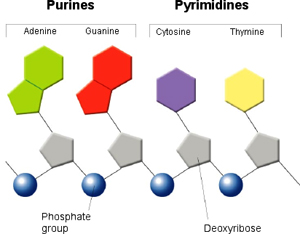RNA
RNA, or Ribonucleic acid, is another type of nucleic acid. Unlike DNA, it is 1 stranded. it is also found in the cytoplasm instead of the nucleus. DNA's nitrogen bases are Adenine, Thymine, Cytosine, and Guanine. However, in RNA, the Thymine is replaced with Uracil. Another difference is that DNA is self-replicating, but RNA is created by a template of DNA.
DNA
Every cell in your body has the exact same copy of DNA. It will copy itself trillions of times using half of the original molecule as a template. First, here is some basic knowledge of DNA structure:
DNA is made up of strings of nucleotides.
A nucleotide is composed of a :
- 5- carbon sugar molecule that is also known as a pentose sugar
- a phosphate group
- nitrogen-containing/nitrogenous base

There are four types of nitrogen bases:
2. Guanine
3. Thymine
4. Cytosine
These make up the middle of the DNA molecule.Adenine is always paired with Thymine and
Cytosine is always paired with Guanine
The nitrogen bases are connected by a hydrogen bond.

The enzyme Helicase "unzips your genes" or breaks this hydrogen bond.
The point where the replication starts is called the Replication Fork. The top strand is knows as the Leading strand while the bottom strand is known as the Lagging strand.
The Leading strand and the Lagging strand get their names because the leading is simpler to copy and the lagging is more difficult. In the Lagging strand, the enzyme DNA Polymerase adds matching nucleotides along the molecule. However, before it can start it needs a primer or something to hook on to. That is where RNA Primase comes in. It adds a primer in the beginning by adding the matching base pairs for a few and then DNA Polymerase can start down the molecule.
On the Lagging strand the process is more complex. DNA Polymerase can only build on strands that are in [5'-->3'] (5 prime to 3 prime) direction and since each sugar phosphate side is antiparallel to each other, the Lagging strand is in the [3'-->5'] (3 prime to 5 prime) direction. For this, RNA Primase has to lay down an occasional short little RNA primer to give polymerase a starting point to work backwards along stand. They work in 1000 to 2000 base pair long segments. These segments are called Ozaki Fragments. After this, DNA Polymerase has to go back and replace RNA primers. Then, the fragments get joined up by an enzyme, DNA Ligase.
DNA replication gets it wrong about 1 in every 10 billion nucleotides. DNA Polymerase also proofread, removing nucleotides from an end of a strand when they discover a mismatched base.
And this is how DNA replicates......
















